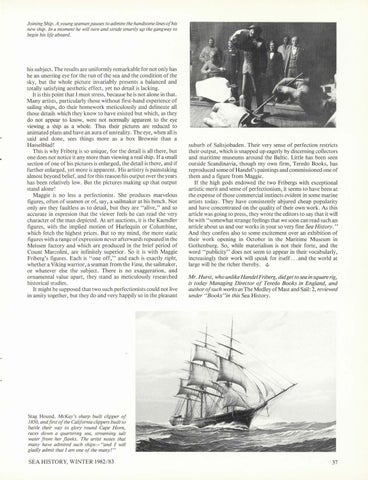Joining Ship. A young seaman pauses lo admire the handsome lines of his new ship. In a moment he will turn and stride smartly up the gangway to begin his life aboard.
his subject. The results are uniformly remarkable for not only has he an unerring eye for the run of the sea and the condition of the sky, but the whole picture invariably presents a balanced and totally satisfying aesthetic effect, yet no detail is lacking. It is this point that I must stress, because he is not alone in that. Many artists, particularly those without first-hand experience of sailing ships, do their homework meticulously and delineate all those details which they know to have existed but which, as they do not appear to know, were not normally apparent to the eye viewing a ship as a whole. Thus their pictures are reduced to animated plans and have an aura of unreality. The eye, when all is said and done, sees things more as a box Brownie than a Hasselblad! This is why Friberg is so unique, for the detail is all there, but one does not notice it any more than viewing a real ship. If a small section of one of his pictures is enlarged, the detail is there, and if further enlarged, yet more is apparent. His artistry is painstaking almost beyond belief, and for this reason his output over the years has been relatively low. But the pictures making up that output stand alone! Maggie is no less a perfectionist. She produces marvelous figures, often of seamen or of, say, a sailmaker at his bench. Not only are they faultless as to detail, but they are "alive," and so accurate in expresion that the viewer feels he can read the very character of the man depicted. At art auctions, it is the Kaendler figures, with the implied motion of Harlequin or Columbine, which fetch the highest prices. But to my mind, the more static figures with a range of expression never afterwards repeated in the Meissen factory and which are produced in the brief period of Count Marcolini, are infinitely superior. So it is with Maggie Friberg's figures. Each is "one off," and each is exactly right, whether a Viking warrior, a seaman from the Vasa, the sailmaker, or whatever else the subject. There is no exaggeration, and ornamental value apart, they stand as meticulously researched historical studies. It might be supposed that two such perfectionists could not live in amity together, but they do and very happily so in the pleasant
suburb of Saltsjobaden. Their very sense of perfection restricts their output, which is snapped up eagerly by discerning collectors and maritime museums around the Baltic. Little has been seen outside Scandinavia, though my own firm, Teredo Books, has reproduced some of Handel's paintings and commissioned one of them and a figure from Maggie. If the high gods endowed the two Fribergs with exceptional artistic merit and sense of perfectionism, it seems to have been at the expense of those commercial instincts evident in some marine artists today. They have consistently abjured cheap popularity and have concentrated on the quality of their own work. As this article was going to press, they wrote the editors to say that it will be with ''somewhat strange feelings that we soon can read such an article about us and our works in your so very fine Sea History." And they confess also to some excitement over an exhibition of their work opening in October in the Maritime Museum in Gothenburg. So, while materialism is not their forte, and the word "publicity" does not seem to appear in their vocabularly, increasingly their work will speak for itself ... and the world at large will be the richer thereby. .t
Mr. Hurst, who unlike Handel Friberg, did get to sea in square rig, is today Managing Director of Teredo Books in England, and author ofsuch works as The Medley of Mast and Sail: 2, reviewed under "Books"in this Sea History.
Stag Hound, McKay's sharp built clipper of 1850, and first of the California clippers built to battle their way to glory round Cape Horn, races down a quartering sea, streaming salt waler from her flanks. The artist notes that many have admired such ships- "and I will gladly admit that I am one of the many!"
SEA HISTORY, WINTER 1982/ 83
37
